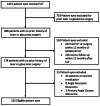Intraocular Pressure Response in the Untreated Contralateral Eye After Selective Laser Trabeculoplasty
- PMID: 39185298
- PMCID: PMC11343485
- DOI: 10.7759/cureus.67537
Intraocular Pressure Response in the Untreated Contralateral Eye After Selective Laser Trabeculoplasty
Abstract
Aim: To examine the impact of selective laser trabeculoplasty (SLT) on intraocular pressure (IOP) in the untreated contralateral eye within 12 months after the procedure.
Methods: A retrospective chart review was conducted on patients with primary open-angle, normal-tension, pigmentary, or pseudoexfoliation glaucoma who received 360-degree SLT at George Washington University. Exclusion criteria included prior or subsequent laser or glaucoma surgery within 12 months of SLT, other glaucoma types, or corticosteroid use during follow-up. Primary outcomes were IOP and medication reduction, and SLT success, defined as reducing IOP by ≥20% without additional IOP-lowering procedures or medications. Follow-up occurred at six weeks, six months, and 12 months. Demographic and clinical data were analyzed using ANOVA, paired t-tests, and chi-squared tests.
Results: A total of 125 patients were included, representing a range of backgrounds: African American (57.6%), Caucasian (31.2%), Asian (5.6%), and Hispanic/Latino (4%), and 1.6% did not report their background. Significant reductions in mean IOP and medication numbers were observed in the contralateral eye at six weeks and six months (p<0.05) but not at 12 months. The contralateral eye success rates were 24% at six weeks and six months and 20.8% at 12 months. The contralateral eye was more likely to achieve success if the ipsilateral eye was successful at six weeks (odds ratio (95% confidence interval): 5.05 (1.89-13.48)), six months (16.1 (4.56-57.17)), and 12 months (5.94 (2.07-17.04)) (p<0.001 for all).
Conclusion: First-time SLT results in statistically significant IOP and medication reductions in the contralateral eye at six weeks and six months. The contralateral eye was 5.05-16.1 times more likely to achieve success if the ipsilateral eye was successful within 12 months.
Keywords: contralateral effect; contralateral eye; glaucoma medication; primary open angle glaucoma; selective laser trabeculoplasty.
Copyright © 2024, Dossantos et al.
Conflict of interest statement
Human subjects: Consent was obtained or waived by all participants in this study. The George Washington University Committee on Human Research, Institutional Review Board (IRB) issued approval NCR213467. The request for an exemption determination for the above-referenced study has been completed. The study was determined to be research that is exempt from IRB review under DHHS regulatory category 4. The project as described in the application may proceed without further oversight by the OHR. Animal subjects: All authors have confirmed that this study did not involve animal subjects or tissue. Conflicts of interest: In compliance with the ICMJE uniform disclosure form, all authors declare the following: Payment/services info: All authors have declared that no financial support was received from any organization for the submitted work. Financial relationships: All authors have declared that they have no financial relationships at present or within the previous three years with any organizations that might have an interest in the submitted work. Other relationships: All authors have declared that there are no other relationships or activities that could appear to have influenced the submitted work.
Figures


References
-
- Selective laser trabeculoplasty as initial and adjunctive treatment for open-angle glaucoma. McIlraith I, Strasfeld M, Colev G, Hutnik CM. J Glaucoma. 2006;15:124–130. - PubMed
-
- Selective targeting of trabecular meshwork cells: in vitro studies of pulsed and CW laser interactions. Latina MA, Park C. Exp Eye Res. 1995;60:359–371. - PubMed
-
- The glaucoma laser trial (GLT) and glaucoma laser trial follow-up study: 7. Results. Glaucoma Laser Trial Research Group. Am J Ophthalmol. 1995;120:718–731. - PubMed
-
- Laser in glaucoma and ocular hypertension (LiGHT) trial. A multicentre, randomised controlled trial: design and methodology. Gazzard G, Konstantakopoulou E, Garway-Heath D, et al. Br J Ophthalmol. 2018;102:593–598. - PubMed
LinkOut - more resources
Full Text Sources
